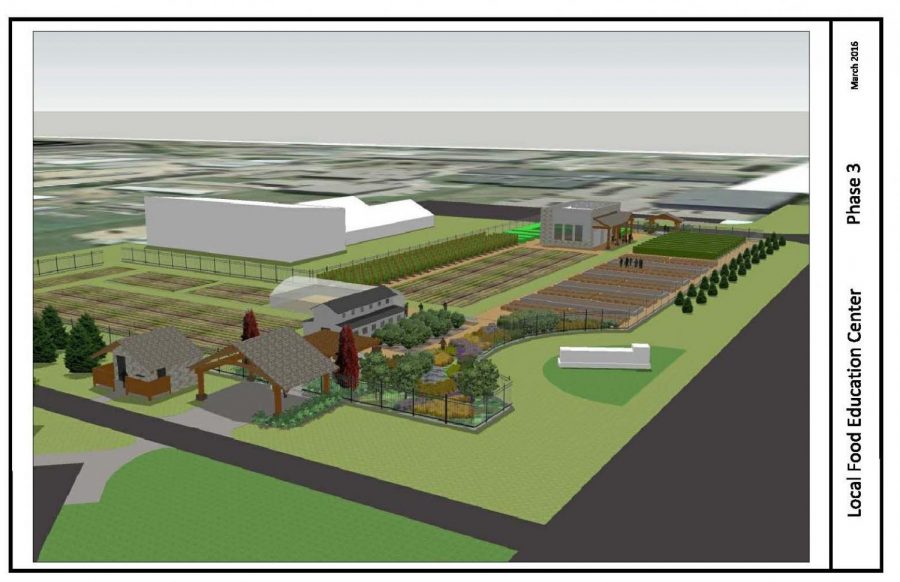Education center boasts local food production techniques
April 27, 2016
Spring 2017 will see the first crop planted of the Local Foods Education Center, a 1.3-acre hands-on learning environment that stemmed from the plant science course ‘Local Foods.
The center will take an in depth look into the urbanized farming of fresh foods and the local distribution.
The facility will be located on Medary Avenue on the northern edge entrance to campus and it will meet the demand for growing local foods markets.
The purpose of this facility is rooted in teaching the different methods of urban farming, which is a growing public interest, according to David Wright, head of the Department of Plant Science.
“The movement to local foods and consumption is wrapped around people wanting to know where their food is coming from and the belief that local food is safer to eat … there’s a vastly growing demand for what’s being locally produced,” Wright said.
This transcending trend has turned into a public thirst for fresher food that has also pushed the plant science department to follow the pattern, Wright said. Not only will the center offer student courses but also courses for the local community.
“This [facility] is a new concept that is more hands on, more structured than what it was in the past and it’s more in demand by students and want-to-be entrepreneurs that want to get involved in local foods production,” Wright said. “It will produce food but we’re not talking about massive amounts of food, this is being put in place to teach students and local residents the techniques for small-scale agriculture … [it will not] compete with local folks who do this for a living.”
The faculty member instructing the local foods course next fall, Brett Owens, believes this will be a fresh experience for the university that will bring more opportunities to campus.
“[I’m most excited for an] exciting new project to be at the ground level of something new, and having a facility like this is truly groundbreaking for the university; to be able to have an education center with this type of access to student horticulture on campus is wonderful,” Owens said. “Also, the chance to work with so many people; all the different colleges on campus will be a very unique and rewarding experience.”
Owens has years of local foods production experience and has a “huge passion for local foods.” He has also worked with local foods producers in the area who are part of the local foods movement to grow the market.
Local foods production is not the same thing as backyard gardening; a more formal definition of local foods is land one to 20 acres that distributes within a 50-mile radius, Wright said.
Techniques used in these food productions are the same techniques large commercial farming uses only on a smaller scale. These methods include low volume irrigation techniques, various weed control techniques and high tunnels that allow earlier planting and later harvesting for the winter months. To accomplish these sorts of practices, water and sewer lines will be installed, electricity will run to the center and a perimeter fence will be erected.
“We’ve started last fall preparing the site. The summer of 2016 will be dedicated to putting in the infrastructure,” Wright said.
According to Owens, exposing students to these types of growing techniques will offer learning opportunities not every university can offer, and this will also be a way for researchers to experiment with these technologies.
“We will be using the facility campus wide and experiment new methods of growing, such as the high tunnel that will help the students learn how to grow in extended growing season and be able to help students by bring them into this high tunnel situation,” Owens said. “Different types of horticulture courses will be able to use the facility, and I foresee in the future almost every type of course in the university could use the site for something or another.”
In the summer months, students will be able to apply for and maintain the local foods education center as a job, as well as enroll in these classes for summer credits.
The building of this facility is currently in phase two of a three-phase implementation, which Wright said has so far cost around $350,000. Phase three is still a couple of years down the road and will feature a full preparation kitchen to show the full process of food from dirt to tablecloth.
“The local foods course has kind of evolved to where it is today and that is a formal part of the plant science and horticulture curriculum. It’s a multimillion-dollar industry around the United States, and when you think of a food desert, which is when someone is more than 10 miles away from fresh food, South Dakota is documented to have several food deserts in it,” Wright said. “We’re meeting growing demand from people who want to know where their food is coming from and want to know that it is fresh.”
While there are still some uncertain future problems that will occur with this facility, the department is confident it will be a successful addition to campus.
“We have a tremendous faculty here at SDSU, and I think that you will see some great things happen here in the near future,” Owens said.
























